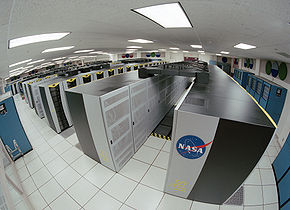
NASA Research and Engineering Network
Encyclopedia

Wide area network
A wide area network is a telecommunication network that covers a broad area . Business and government entities utilize WANs to relay data among employees, clients, buyers, and suppliers from various geographical locations...
which connects selected NASA
NASA
The National Aeronautics and Space Administration is the agency of the United States government that is responsible for the nation's civilian space program and for aeronautics and aerospace research...
centers and peers with other high-performance network test-beds. It enables NASA scientists, engineers, and researchers to reach their partners within other federal agencies and academia.
The NREN was initially developed in 1996 and has been upgraded several times. It currently has 10 Gigabits-per-second (Gbit/s) connectivity across the continental United States, primarily to link to the Columbia supercomputer
Columbia (supercomputer)
Named in honor of the crew who died in the Columbia disaster, Columbia is a supercomputer built by Silicon Graphics for NASA. Its main purpose was to simulate the violent collision and merger of spiral galaxies that lead to the formation of elliptical galaxies...
at the NASA Ames Research Center
NASA Ames Research Center
The Ames Research Center , is one of the United States of America's National Aeronautics and Space Administration 10 major field centers.The centre is located in Moffett Field in California's Silicon Valley, near the high-tech companies, entrepreneurial ventures, universities, and other...
in Moffett Field, California.
In March of 2006, NREN developed and implemented a custom wireless networking protocol known as Dynamic Source Routing (DSR). DSR was to be used by field teams and robots to facilitate communication in difficult field conditions.
In September 2006 the NREN was used to develop a high transfer rate application called BBFTP to support GOES 5
GOES 5
GOES 5, known as GOES-E before becoming operational, was a geostationary weather satellite which was operated by the United States National Oceanic and Atmospheric Administration as part of the Geostationary Operational Environmental Satellite system...
operations between Ames and Goddard Space Flight Center
Goddard Space Flight Center
The Goddard Space Flight Center is a major NASA space research laboratory established on May 1, 1959 as NASA's first space flight center. GSFC employs approximately 10,000 civil servants and contractors, and is located approximately northeast of Washington, D.C. in Greenbelt, Maryland, USA. GSFC,...
(GSFC). BBFTP achieved transfer rates as high as 52 Megabytes/sec, and a net transfer of well over 4 Terrabytes worth of data.
The NREN supported operations of the McGill High Arctic Research Station (MARS).

